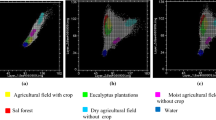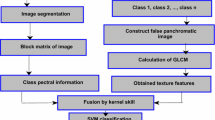Abstract
Snow cover has a significant impact on numerous ecological, climatic, and hydrological processes, particularly in high-latitude areas. Remote sensing data estimates of snow cover ranges than traditional surveying methods. Thus, the present study used Sentinel-2B satellite images to compare the performance of support vector machine (SVM) kernel functions and object-oriented fuzzy operators to estimate the snow cover area (SCA) on Alvand Mountain. The research data included four Sentinel-2B 10 m spatial resolution bands (B2, B3, B4, and B8) that were launched on March 6, 2020. In this study, linear, polynomial, radial, and sigmoid SVM kernel functions, as well as the object-oriented fuzzy operators (AND, OR, MGE, MAR, MGWE, and ALP), were used. The results indicated that AND algorithm, which represents a logical commonality, had the lowest return fuzzy value of 98% compared to other algorithms, thus, providing the overall highest accuracy. Based on these findings, the object-oriented processing method in digital image classification could provide the highest accuracy compared to the SVM kernel functions; that is because a wide range of information, such as texture, shape, position, content, and bandwidth, is associated with the objects in this classification method. Finally, the SCA in Alvand Mountain was estimated to be 604 km2 based on the object-based AND fuzzy operator.





Similar content being viewed by others
Data availability
Available data is presented in the manuscript as figures and tables.
Code availability
N/A.
Abbreviations
- OBIA:
-
Object-based image analysis
- RS:
-
Remote sensing
- SCA:
-
Snow cover area
- SLT:
-
Statistical learning theory
- SVM:
-
Support vector machine
References
Aksoy B, Ercanoglu M (2012) Landslide identification and classification by object-based image analysis and fuzzy logic: an example from the Azdavay region (Kastamonu, Turkey). Comput Geosci 38:87–98. https://doi.org/10.1016/j.cageo.2011.05.010
Alonso-González E, López-Moreno J, Gascoin S, García-Valdecasas Ojeda M, Sanmiguel-Vallelado A, Navarro-Serrano F, Revuelto J, Ceballos A, Esteban-Parra M, Essery R (2018) Daily gridded datasets of snow depth and snow water equivalent for the Iberian Peninsula from 1980 to 2014. Earth Syst Sci Data 10:303–315. https://doi.org/10.5194/essd-10-303-2018
Armstrong RL, Brun E (2008) Snow and climate: physical processes, surface energy exchange and modeling. Cambridge University Press, Cambridge
Azizi G, Rahimi M, Mohammadi H, Khoshakhlagh F (2017) Spatio-temporal variations of snow cover in the southern slope of central Alborz. Phys Geogr Res Q 49:381–393. https://doi.org/10.22059/jphgr.2017.217393.1006943
Benz UC, Hofmann P, Willhauck G, Lingenfelder I, Heynen M (2004) Multi-resolution, object-oriented fuzzy analysis of remote sensing data for GIS-ready information. ISPRS J Photogramm Remote Sens 58:239–258. https://doi.org/10.1016/j.isprsjprs.2003.10.002
Blaschke T (2010) Object based image analysis for remote sensing. ISPRS J Photogramm Remote Sens 65:2–16. https://doi.org/10.1016/j.isprsjprs.2009.06.004
Boi P (2010) Snow cover retrieval over Italy and alpine regions using MSG data for climatologic purposes. Meteorol Appl 17:313–320. https://doi.org/10.1002/met.172
Çiftçi BB, Kuter S, Akyürek Z, Weber GW (2017) Fractional snow cover mapping by artificial neural networks and support vector machines. ISPRS Ann Photogramm Remote Sens Spatial Inf Sci, IV-4/W4:179–187. https://doi.org/10.5194/isprs-annals-IV-4-W4-179-2017
Czyzowska-Wisniewski EH, van Leeuwen WJ, Hirschboeck KK, Marsh SE, Wisniewski WT (2015) Fractional snow cover estimation in complex alpine-forested environments using an artificial neural network. Remote Sens Environ 156:403–417. https://doi.org/10.1016/j.rse.2014.09.026
Esetlili MT, Bektas Balcik F, Balık Şanlı F, Kalkan K, Üstüner M, Göksel C, Gazioğlu C, Kurucu Y (2018) Comparison of object and pixel-based classifications for mapping crops using Rapideye imagery: a case study of Menemen Plain, Turkey. Int J Environ Geoinformatics (IJEGEO) 5:231–243. https://doi.org/10.30897/ijegeo.442002
Feizizadeh B, Blaschke T, Tiede D, Moghaddam M (2017) Evaluating fuzzy operators of an object-based image analysis for detecting landslides and their changes. Geomorphology 293:240–254. https://doi.org/10.1016/j.geomorph.2017.06.002
Garen DC, Marks D (2005) Spatially distributed energy balance snowmelt modelling in a mountainous river basin: estimation of meteorological inputs and verification of model results. J Hydrol 315:126–153. https://doi.org/10.1016/j.jhydrol.2005.03.026
Gascoin S, Grizonnet M, Bouchet M, Salgues G, Hagolle O (2019) Theia snow collection: high-resolution operational snow cover maps from Sentinel-2 and Landsat-8 data. Earth System Science Data 11:493–514. https://doi.org/10.5194/essd-11-493-2019
Hall DK, Riggs GA, Salomonson VV, DiGirolamo NE, Bayr KJ (2002) MODIS snow-cover products. Remote Sens Environ 83:181–194. https://doi.org/10.1016/S0034-4257(02)00095-0
Hou J, Huang C, Chen W, Zhang Y (2021) Improving snow estimates through assimilation of MODIS fractional snow cover data using machine learning algorithms and the common land model. Water Resour Res 57:e2020WR029010. https://doi.org/10.1029/2020WR029010
Kuter S (2021) Completing the machine learning saga in fractional snow cover estimation from MODIS Terra reflectance data: random forests versus support vector regression. Remote Sens Environ 255:112294. https://doi.org/10.1016/j.rse.2021.112294
Liu C, Huang X, Li X, Liang T (2020) MODIS fractional snow cover mapping using machine learning technology in a mountainous area. Remote Sens (Basel) 12:962. https://doi.org/10.3390/rs12060962
Lopez P, Sirguey P, Arnaud Y, Pouyaud B, Chevallier P (2008) Snow cover monitoring in the Northern Patagonia Icefield using MODIS satellite images (2000–2006). Global Planet Change 61:103–116. https://doi.org/10.1016/j.gloplacha.2007.07.005
López-Moreno JI, Soubeyroux JM, Gascoin S, Alonso-Gonzalez E, Durán-Gómez N, Lafaysse M, Vernay M, Carmagnola C, Morin S (2020) Long-term trends (1958–2017) in snow cover duration and depth in the Pyrenees. Int J Climatol 40:6122–6136. https://doi.org/10.1002/joc.6571
Mountrakis G, Im J, Ogole C (2011) Support vector machines in remote sensing: a review. ISPRS J Photogramm Remote Sens 66:247–259. https://doi.org/10.1016/j.isprsjprs.2010.11.001
Muhammad S, Thapa A (2020) An improved Terra—Aqua MODIS snow cover and Randolph Glacier Inventory 6.0 combined product (MOYDGL06*) for high-mountain Asia between 2002 and 2018. Earth System Science Data 12:345–356. https://doi.org/10.5194/essd-12-345-2020
Najafi P, Navid H, Feizizadeh B, Eskandari I, Blaschke T (2019) Fuzzy object-based image analysis methods using Sentinel-2A and Landsat-8 data to map and characterize soil surface residue. J Remote Sens 11:2583. https://doi.org/10.3390/rs11212583
Notarnicola C (2020) Hotspots of snow cover changes in global mountain regions over 2000–2018. Remote Sens Environ 243:111781. https://doi.org/10.1016/j.rse.2020.111781
Prasad SVS, Savithiri TS, Krishna VM (2017) Performance evaluation of SVM kernels on multispectral LISS III data for object classification. Int J Smart Sens Intell Syst 10:1–16. https://doi.org/10.21307/ijssis-2018-020
Priyadharshini S, Subramoniam SR, Raj KG, Anandhi V (2019) Coconut inventory and mapping using object oriented classification. Int J Curr Microbiol App Sci 8(8):58–65. https://doi.org/10.20546/ijcmas.2019.808.007
Terzago S, Cassardo C, Cremonini R, Fratianni S (2010) Snow precipitation and snow cover climatic variability for the period 1971–2009 in the Southwestern Italian Alps: the 2008–2009 snow season case study. Water 2:773–787. https://doi.org/10.3390/w2040773
Thompson JA, Lees BG (2014) Applying object-based segmentation in the temporal domain to characterise snow seasonality. ISPRS J Photogramm Remote Sens 97:98–110. https://doi.org/10.1016/j.isprsjprs.2014.08.010
Ustuner M, Sanli FB, Dixon B (2015) Application of support vector machines for landuse classification using high-resolution rapideye images: a sensitivity analysis. Eur J Remote Sens 48:403–422. https://doi.org/10.5721/EuJRS20154823
Wei M, Qiao B, Zhao J, Zuo X (2019) The area extraction of winter wheat in mixed planting area based on Sentinel-2 a remote sensing satellite images. Int J Parallel, Emergent Distrib Syst 35:297–308. https://doi.org/10.1080/17445760.2019.1597084
Author information
Authors and Affiliations
Contributions
MK and AHalabian designed the project. All authors analyzed the data and wrote the manuscript. All authors approved the final version of the manuscript.
Corresponding author
Ethics declarations
Ethics approval
N/A.
Consent to participate
N/A.
Consent for publication
N/A.
Conflict of interest
The authors declare no competing interests.
Additional information
Publisher’s Note
Springer Nature remains neutral with regard to jurisdictional claims in published maps and institutional affiliations.
Rights and permissions
Springer Nature or its licensor (e.g. a society or other partner) holds exclusive rights to this article under a publishing agreement with the author(s) or other rightsholder(s); author self-archiving of the accepted manuscript version of this article is solely governed by the terms of such publishing agreement and applicable law.
About this article
Cite this article
Karampour, M., Halabian, A., Hosseini, A. et al. Comparing the performance of fuzzy operators in the object-based image analysis and support vector machine kernel functions for the snow cover estimation in Alvand Mountain. Theor Appl Climatol 155, 1729–1737 (2024). https://doi.org/10.1007/s00704-023-04724-6
Received:
Accepted:
Published:
Issue Date:
DOI: https://doi.org/10.1007/s00704-023-04724-6




